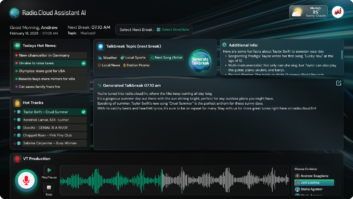One of the emerging technical trends to be discussed at the 2011 Broadcast Engineering Conference at the NAB Show is cloud computing. It is a term new to many broadcasters, though the technology has been developing for some time and has been discussed at recent past conventions. The cloud gets an expanded look this year.
Basically cloud computing involves using the Internet for tasks you usually accomplish with your own computer. All of your information lives on a server farm.

As A.J. Janitschek of Radio Free Asia explained in a presentation at last year’s NAB Show, cloud computing offers several advantages. But it is not without risk and other downsides. Cloud users need not be concerned with the location of applications or data; they only need a computer with Internet access. This gives users the advantage of “anywhere/anytime” access to information with a device as simple as a netbook. Anyone using Google Gmail is involved with cloud computing.
For businesses, the advantage is that the computing infrastructure can be outsourced, leaving them free to focus on core competencies. The bottom line is higher efficiency with lower cost. Broadcasters gain the advantage of having access to applications and services they otherwise could not afford.
Delivery
Cloud computing usually is delivered in one of three ways: Software as a Service (SaaS), Platform as a Service (PaaS) and Infrastructure as a Service (IaaS).
With SaaS, vendors license applications to customers for use on-demand. GoogleApps is one such service.
With PaaS, the provider delivers a computing platform where users can develop, test, deploy, host and maintain applications in the same integrated environment. Two examples are BungeeLabs and Microsoft Azure.
Infrastructure as a Service involves the buyer using the service provider’s equipment. The vendor provides the client with virtual machines and storage. With IaaS, users may realize an economy of scale through volume operations. There is no IT facility or maintenance; applications and servers stay current. Operating costs are reduced through pay-per-use, and stations can focus on the core activities of broadcasting while outsourcing IT operations.
Rethink
Adopting cloud computing demands a complete rethink of the design, operation and planning of a station’s data center.
A traditional project would involve planning space utilization with a 3D CAD program and using predictive analysis software to understand energy and cooling requirements. Add to this recent research that suggests power consumption increases of over 600 percent in seven years, and switching to cloud computing may be a lot cheaper than building your own data center.
While working in the cloud is new to many broadcasters, industries such as insurance, government, healthcare and financial services are on board. The city of Orlando reduced its IT costs by 60 percent using Google Apps. It was also one of the first cities to switch its employees to Gmail.
Among early adopters of this technology in radio broadcasting were NPR and Sirius Satellite Radio. Both are using Isilon’s NAS (Network Attached Storage) for media storage. Both employ large numbers of media production workstations. NAS allows centralized storage of large amounts of media that can be accessed via the Internet at broadcast centers around the globe. In the case of NPR, Isilon also provides replication software for disaster recovery preparedness.
But getting aboard the cloud need not be a high-stakes game. Radio Free Asia is developing a private cloud to link their global operations using Ubuntu Enterprise Cloud. This is a Linux-based, open-source solution that is compatible with Amazon’s EC2 public cloud applications.
More opportunity
‘Cloud-Based Technologies for Broadcast’ A Monday morning group sessions, chaired by Greg DePriest, vice president of technology policy for NBC Universal, explores the topic of the cloud at the NAB Show.
Al Kovalick of Avid will address “Planning for the Cloud: Essential Concepts and Applications for the Media Facility.” John Hoehn of IBM Media and Entertainment will ask, “Does Cloud Computing Matter? Or, Is There a Cloud in Your Future?” And Todd Martin and William Hendler of Chyron will offer a video-oriented presentation on how “Cloud-Based Graphics Creation Offers Broadcasters Lofty Rewards.”
Cloud-related presentations also are part of the sessions “Mission-Critical IT for Broadcast” Monday afternoon, the “Radio Engineering Forum” Tuesday afternoon and “Internet-Enabled Radio and Television” Wednesday afternoon. Some broadcast equipment manufacturers are putting the cloud to use. Broadcast Electronics’ The Radio Experience was an early adopter of the technology, beginning six years ago with its Message Manager program.
“At first, stations didn’t like the idea of having their data in the cloud,” Jim Roberts, product manager for datacast systems at BE, said during NAB last year, “but eventually they warmed up to the concept.”
At RCS, President/CEO Philippe Generali noted at last year’s convention that two of the company’s products, Mediabase and Media Monitors, use the cloud in order to make data about radio stations, music and advertising available to its customers in near-real time.
But every silver cloud has a dark lining. Issues that need to be considered include abuse and ill-intended use; insecure application programming; malicious insiders; shared technology vulnerabilities; data loss and leakage; account service and data hijacking and unknown risk profiles. Bandwidth limitations may prevent moving large media files in and out of the cloud quickly. More intangible concerns with the cloud include loss of control as well as trust issues around security and privacy.
Some of these intangibles can be addressed by using a hybrid model with a private cloud built within the company’s firewall to provide greater data security. Less-sensitive materials may be outsourced to the public cloud.
Cloud computing offers broadcasters freedom from the traditional constraints of operating from a single geographic location. Content is available anywhere there is Internet access. It remains to be seen how quickly the required high bandwidth can become universally available.
While cloud computing is in its infancy in the broadcast arena, the potential benefits, especially financial, may have managers asking not whether they can afford cloud computing, but whether they can afford not to have it.







